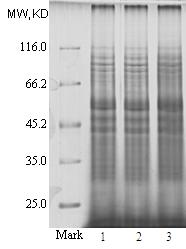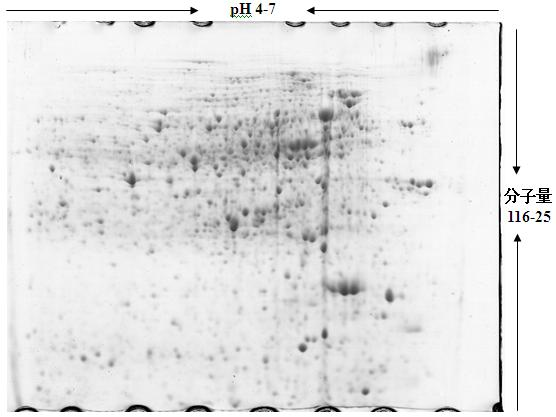Extraction separation method for soil intracellular protein
A protein separation and separation method technology, which is applied in the fields of peptide preparation, chemical instruments and methods, organic chemistry, etc., can solve the problems of interfering with the extraction of intracellular protein in soil, and achieve the effect of clear protein spots.
- Summary
- Abstract
- Description
- Claims
- Application Information
AI Technical Summary
Problems solved by technology
Method used
Image
Examples
Embodiment 1
[0040] Weigh 1 g of rice soil and add 5 mL of 0.05 mol / L sodium citrate buffer into a 10 mL centrifuge tube. Shake well on a vortex shaker for 3 hours. After shaking, place the centrifuge tube in precooling to 4 o Centrifuge at 15,000 rpm for 25 min in a centrifuge in C, and discard the supernatant. Add 5mL sodium citrate buffer solution to the centrifuge tube and shake it in a vortex shaker for 10min, then pre-cool to 4 o Centrifuge at 15,000 rpm for 25 min in a centrifuge in C, discard the supernatant, and repeat 2 times. Add 5 mL of SDS buffer into the centrifuge tube, and place it in a vortex shaker for 1 hour. After shaking, the supernatant was passed through a 0.45 μm filter membrane and transferred to a new 10 mL centrifuge tube, 2 mL of Tris-saturated phenol (pH 8.0) was added, placed in a vortex shaker for 30 min, and then allowed to stand for 30 min. Then pre-cool the centrifuge tube to 4 o C centrifuge at 15000rpm for 25min, take the lower layer of phenol liqui...
Embodiment 2
[0047] Take 0.8g of sugarcane soil, add 0.05mol / L, pH8.0 sodium citrate buffer 4mL, oscillate in a vortex shaker for 2.5 hours, centrifuge at 15000rpm for 25min, discard the supernatant; take the precipitate, add 0.05mol / L, pH8.0 sodium citrate buffer 4mL, shake in a vortex shaker for 10min, then centrifuge at 15000rpm for 25min, discard the supernatant, repeat twice; take the precipitate, add 4mL of SDS buffer, shake in a vortex shaker for 50min; After the end, centrifuge at 15000rpm for 25min, collect the supernatant, and pass through a 0.45μm microporous membrane, take the filtrate and add 2mL of Tris-saturated phenol with a pH of 8.0, place it in a vortex shaker for 25min, let it stand for 20min, and then 15000rpm Centrifuge for 25 minutes, remove the lower phenol phase, add 5 times the volume and pre-cool to 4 o 0.1mol / L methanol-ammonium acetate solution of C, placed at -20 o Precipitate under C condition overnight, then centrifuge at 15000rpm for 25min; discard superna...
Embodiment 3
[0053] Take 1.5g of tobacco soil, add 0.05mol / L, pH8.0 sodium citrate buffer 6mL, shake in a vortex shaker for 4 hours, centrifuge at 15000rpm for 25min, discard the supernatant; take the precipitate, add 0.05mol / L, pH8.0 sodium citrate buffer 4-6mL and shake in a vortex shaker for 10-20min, then centrifuge at 15000rpm for 25min, discard the supernatant, repeat twice; take the precipitate, add 6mL of SDS buffer, put in a vortex shaker Shake for 80 minutes; after shaking, centrifuge at 15,000 rpm for 25 minutes, collect the supernatant, and pass through a 0.45 μm microporous membrane, take the filtrate and add 3 mL of Tris-saturated phenol with a pH of 8.0, place it in a vortex shaker for 40 minutes, and let it stand 50min, then centrifuge at 15000rpm for 25min, remove the lower phenol phase, add 5 times the volume and pre-cool to 4 o 0.1mol / L methanol-ammonium acetate solution of C, placed at -20 o Precipitate under C condition overnight, then centrifuge at 15000rpm for 25min...
PUM
 Login to View More
Login to View More Abstract
Description
Claims
Application Information
 Login to View More
Login to View More - R&D
- Intellectual Property
- Life Sciences
- Materials
- Tech Scout
- Unparalleled Data Quality
- Higher Quality Content
- 60% Fewer Hallucinations
Browse by: Latest US Patents, China's latest patents, Technical Efficacy Thesaurus, Application Domain, Technology Topic, Popular Technical Reports.
© 2025 PatSnap. All rights reserved.Legal|Privacy policy|Modern Slavery Act Transparency Statement|Sitemap|About US| Contact US: help@patsnap.com


